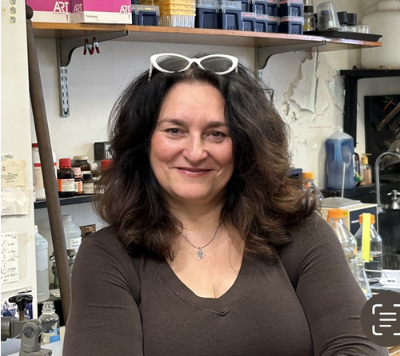A Small Bat with Enormous Potential for Aging Studies
Dr. Rena Orman is not the only neurobiologist who works with bats. Nor is she the first. But she may well be the biggest booster of using the flying mammal as a model organism for studying the effects of aging in humans.
For many years Orman, a research associate professor at SUNY Downstate Health Sciences University, has been interested in a part of the brain called “claustrum.” The sheet-like neuronal structure has a remarkable neuroanatomy—almost every type of sensory information feeds into claustrum, which sends outputs to the primary and association cortices, the highest-level processing centers of the brain.
|
|
Several investigators believe that claustrum is one of the most important structures for cognition. To understand how claustrum does what it does, Orman is conducting experiments to reveal how its network of excitatory and inhibitory neurons works.
The research showed a rich system of inhibitory cells in claustrum that may enable claustrum to respond to important inputs while ignoring non-important inputs that may be arriving at the same time, a concept called inhibitory control. “When inhibitory cells are lost, the function of the remaining cells is radically altered,” explained Orman, noting that inhibitory neurons are among the earliest to be lost in neurodegenerative diseases such as Alzheimer’s.
“This it has been a hard nut to crack because of claustrum’s slender shape in rats and mice, which are the prevalent animal models for this type of research,” said Orman.
Overcoming this lack of accessibility is where bats come in. Bats are not rodents. Their neuroanatomy is more similar to that of humans, with larger brain structures like claustrum and amygdala than any other animal their size. On top of that, they can live much longer than mice and rats—up to two decades in some bat species vs. up to only two or three years in rodents.
Orman was fortunate to have a colony of Seba’s short-tailed fruit bats (Carollia perspicillata) “fall into her lap” when Dr. John Rasweiler, who pioneered studies of bat reproduction and development at Downstate, retired. Critically, Carollia allows Orman to study both the claustrum and its changes with age. “We hope to better understand brain aging through the lens of areas such as claustrum and hippocampus, another area hit hard by neurodegeneration,” said Orman. “These areas in the bat offer us a chance to study natural losses of inhibition due to aging in contrast to losses driven by genetic modifications.”
Aging studies do not lend themselves to rapid-fire experiments. Zebrafish, mice, rats, and other common animal models have been very productive for scientific research, but they all come with short lifespans. “If you choose one of them to study aging, you have to argue that the decades-long aging process in humans and non-human primates is simply compressed into a few days or months, but otherwise faithfully replicated,” explained Orman. “I think the jury is still out on this question and I am putting my money on a longer-lived model animal.”
No animal model is suited to answer every question. According to Orman, bats (Carollia in particular) offer unique advantages as an animal model in laboratory settings. Carollia is the size of a mouse. It lives a long time – more than ten years in captivity. And many aspects of its anatomy and physiology are remarkably close to humans.
The drawback? It is hard to get funding. “During grant reviews all of us who do bat research are routinely asked why we don’t work with mice,” said Orman. “We have to spend precious grant application space to explain the value of bats as a model.”
Overcoming this resistance requires patience and education. Earlier this year, Orman had the opportunity to co-organize a virtual workshop on “What Bats Can Teach Us About Aging” that was sponsored by the National Institute on Aging. It brought together bat researchers from Europe and across the United States, with topics as varied as longevity mechanisms, reproductive aging, bone biomechanics, and bat-derived stem cells, and drew 180 registrants.
For her own work on claustrum and aging in Carollia, Orman and her collaborators have spent several years laying the groundwork. They have validated important tools such as antibodies for immunohistochemistry and Western blotting that allowed them to identify the molecular players and their distribution in multiple brain areas in Carollia and other bat species. They are establishing the precise ages of the animals in their colony by using a DNA methylation assay (the Horvath clock).
The next steps are to demonstrate the changes that occur in bat brain structures due to aging and to define which brain areas degenerate in old animals as compared to young and middle-aged ones. This work will be critical for showing that aging studies in bats are possible and teach us much about aging and neurodegeneration.
Orman is thankful to have received funding from the National Institute on Aging and a SUNY Downstate Seed grant to do this important work. She also appreciates the essential grant management services provided by the SUNY Research Foundation (RF); in particular, by Laurian Bradford and the Sponsored Programs Administration team at Downstate and Matthew Mroz and the Industry and External Affairs team at RF Central Office. Their coordinated support allows her to focus her time and effort on improving our understanding of brain aging.
“Ours is a small community that wishes to grow,” said Orman. “There are few laboratory colonies of bats in the United States, and ours is probably one of the oldest. We collaborate with many people both inside and outside of SUNY because this resource is so precious.”
comments powered by Disqus



 SUNY Downstate Research Associate Professor Rena Orman, PhD, is focused on developing the Seba's short-tailed fruit bat as a model organism for aging studies.
SUNY Downstate Research Associate Professor Rena Orman, PhD, is focused on developing the Seba's short-tailed fruit bat as a model organism for aging studies.